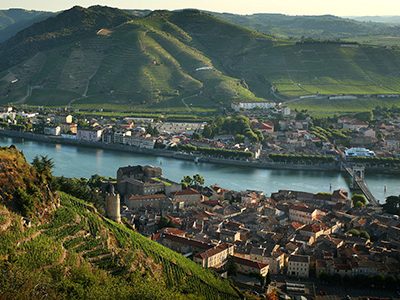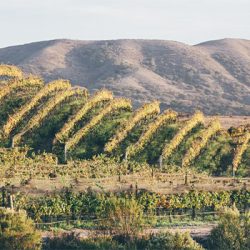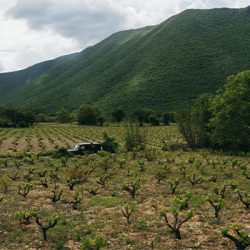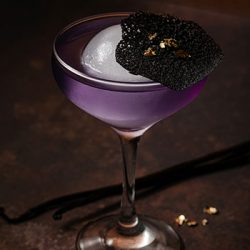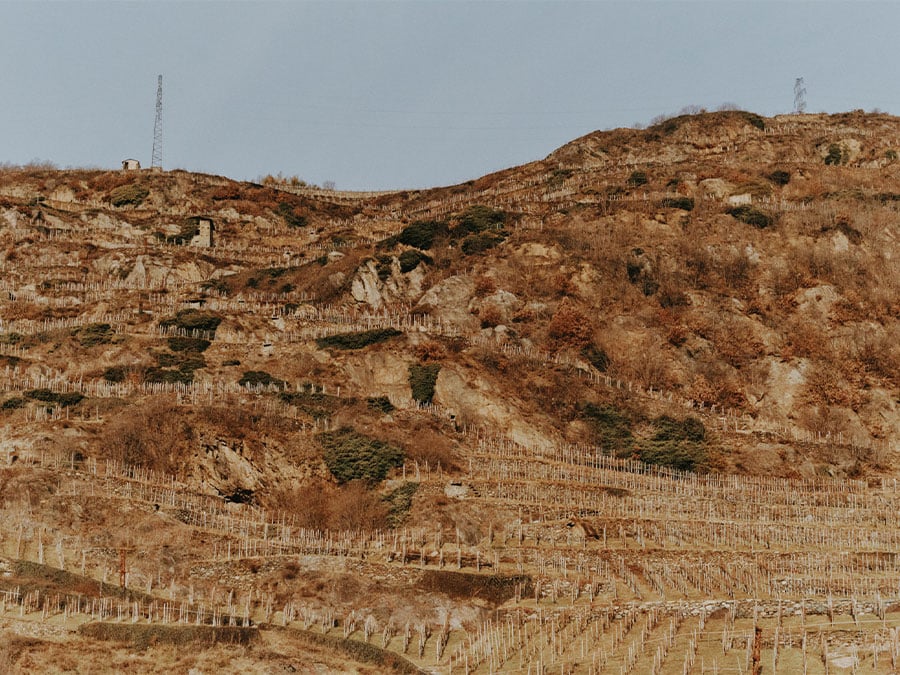

“Do you have a problem with verticality?” Davide Fasolini asked as we climbed a set of stone steps leading to one of his vineyard plots. We were in the Grumello subzone, some 800 feet above the town of Sondrio.
Reaching the vineyard, we could look along the narrow valley toward Valtellina’s eastern end, just a mile from the Swiss border. Westward lies Lake Como, the source of la breva, a wind that blows through the valley every afternoon. Below spreads a network of centuries-old stone terraces and rows of vines climbing up the impossibly steep slopes. It’s a breathtakingly beautiful place, and one of the hardest in Italy in which to make wine.
Faso, as he is known locally, is among a cohort of producers trying to gain a foothold in this highly traditional region in northern Lombardy. He and Pierpaolo “Bierba” Di Franco, his partner in the Dirupi winery, grew up in Sondrio and studied viticulture and oenology at the University of Milan. They returned to Valtellina in 2004, swimming against a tide of young people who were leaving the valley and abandoning their parents’ vineyards, for whom working vines in poor soils on steep slopes held little appeal.
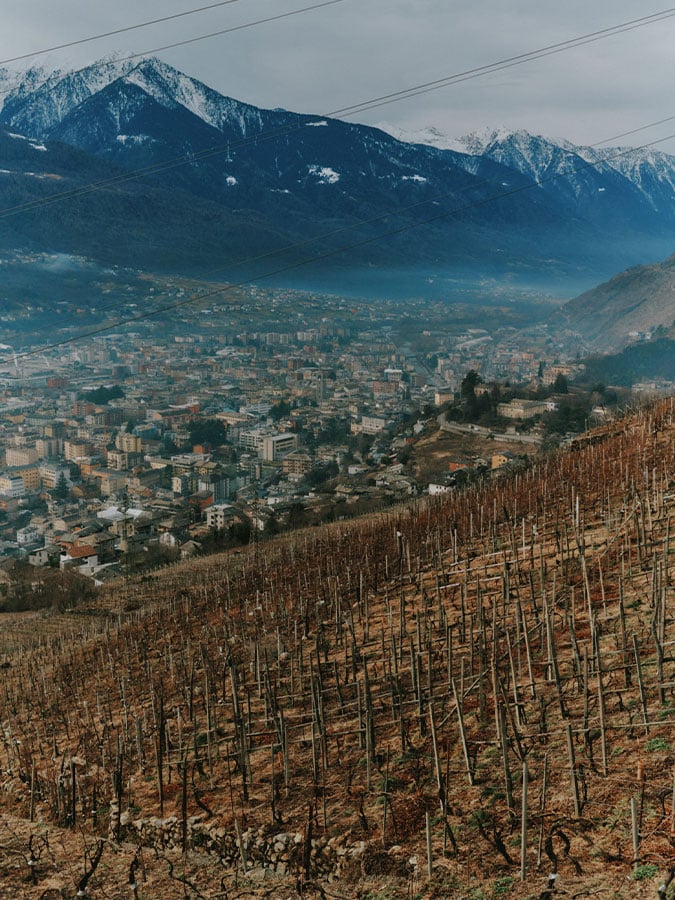

Neither came from a winemaking family, so the two friends started from scratch, renting an 18th-century stone palazzo for cellar space and leasing small plots of vines. Working in a place like Valtellina presented an education beyond the scope of their degrees, Faso recalls. “We connected with the oldest growers, some 80 years old, who had the same ideas as us—attention to pruning, not too much weight on the vine. They were our professors in the vineyards. They would tell us what we were doing wrong. We had university training, but they taught us about the reality of this place.”
Over the course of 20 harvests, Faso and Bierba have collected small plots of vines, now owning 3.7 acres and renting 18.5. They make improvements in each parcel, adding new posts and soft-pruning the vines to keep the sap flowing freely—often under the watchful eyes of neighboring growers who were initially skeptical of their new methods. But, gradually, as those neighbors age out of vineyard work and have no heirs who want to take over, some of them have approached the Dirupi partners to manage their plots. “For us, this is the highest compliment,” says Faso.
Over lunch in Sondrio, we taste through some of Dirupi’s current releases and talk about the diversity of Valtellina’s terroir. They make a lively Rosso di Valtellina with thin-skinned grapes from the lower vineyard plots. The highest and steepest tiers of terraces receive the most direct sunlight, producing grapes with thicker skins, yet the temperatures can swing 40° Fahrenheit from day to night, slowing the maturation of the seeds and keeping acidity levels high. Faso and Bierba make a Valtellina Superiore with fruit from ten different vineyards to capture some of these differences in elevation, as well as soil depth and vine age. They also produce three single-vineyard wines—two from Grumello and one from Inferno—to highlight the characteristics of specific plots. The through line in all of their wines is verticality: Nebbiolo from the Alps is fresh and herbal. Barolo lovers will recognize the grape’s red berry and plum flavors, but nebbiolo grown on Valtellina’s sandy slopes is lighter in tannin and more ethereal in texture than the dense, powerful wines from the Langhe’s warmer slopes and clay-rich soils.
The fact that consumer tastes have gravitated in recent years toward fresher and lighter styles of wine is not lost on Valtellina producers, and Faso has felt a sense of growing opportunity in the valley. “There are a lot of new little producers, some really interesting younger guys that work…not in a new way, because there’s nothing to invent here—we have stone terraces from 1,000 years ago and nebbiolo for many years—but they are trying to put in the bottle our little pieces of land and give the finest expression that is possible from our territory.” Driving along Via Panoramica toward Dirupi’s cellar, Faso nods at a house with a small, hand-lettered sign next to the garage door. “That’s Marco Ferrari’s cellar. He’s making some of the best wines in Valtellina.”
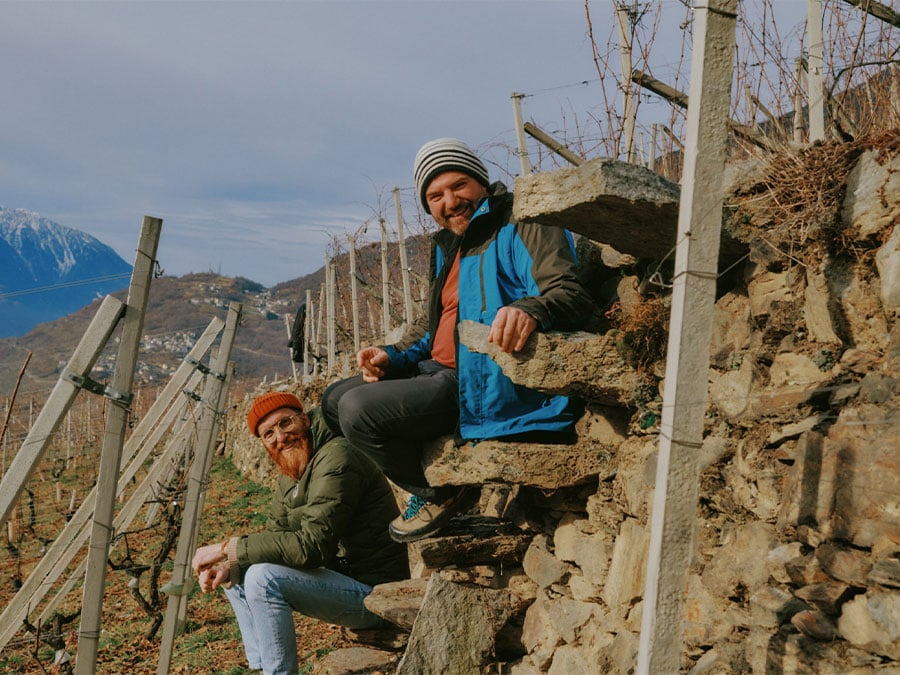

Ferrari hadn’t been on my radar, but he found some time to see me a couple of days later. We met at his cellar—he rents part of the ground floor of the house, a large open space the owner had been using to age cheese. Ferrari is a native of Lombardy but a newcomer to Valtellina, having moved here in 2018 after working in Franciacorta and, later, for Franck Balthazar in France’s Rhône Valley.
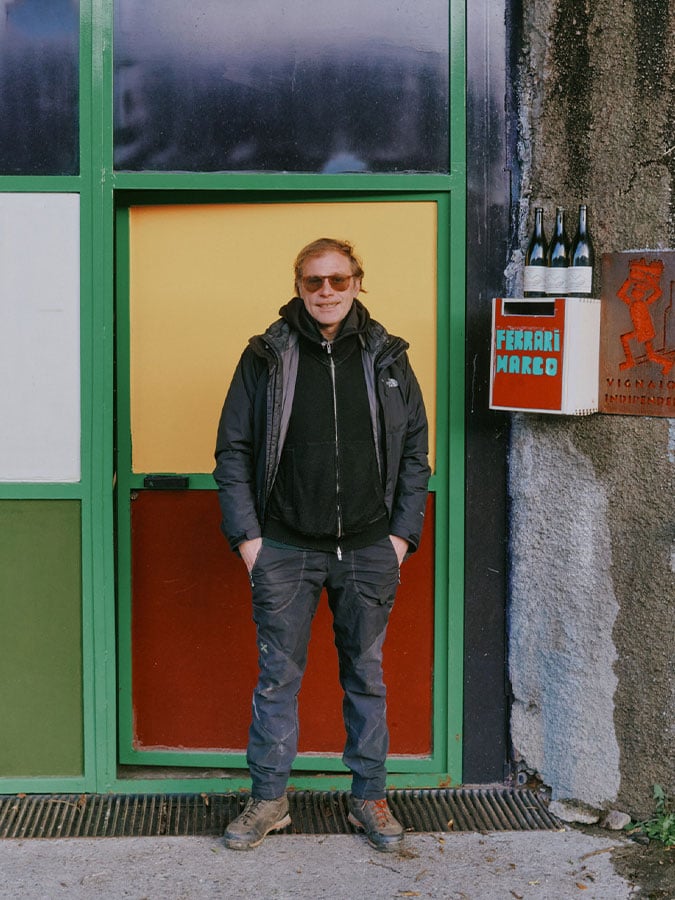

Like the Dirupi partners, Ferrari is slowly building his vineyard acreage by renting plots and buying a little land each year. His cellar work may not be new, but it is, in fact, different from contemporary winemaking practice in Valtellina—mostly in his use of whole bunches in his fermentations, a practice he picked up from Balthazar. He has moved slowly, though, respecting the fact that he is new to this place. “I started with only three wines, and destemmed all of the grapes, because I wanted to learn and understand my terroir.” All his fermentations are spontaneous, and he uses minimal sulfur and no fining or filtering, but he’s not dogmatic about it. “Every vintage is different, and I am not the Taliban. I might have to change for some reason. Also, I don’t call my wines ‘natural,’ because the natural product of grapes is vinegar.”
Ferrari now works almost seven acres and produced 11,500 bottles in 2022. This year will be 30 percent less, he says, due to wet conditions during the growing season—a constant concern here since every vineyard operation has to be done manually, and spraying against mildew demands speed. Ferrari tells me that Valtellina vineyards require an average of over 600 hours of labor per acre—a figure that almost every producer quotes—up to 15 times the labor hours required in some of Italy’s flatter wine regions.
If making wine in Valtellina is that difficult, I ask, why did you come? His answer is long and thoughtful but boils down to this: He believes nebbiolo is the best Italian red grape, it’s too expensive to buy land in the Langhe to make Barolo, and climate change has now allowed nebbiolo in Valtellina to arrive at peak ripeness more consistently than in the past. “I can make wines with less structure than Barolo, but with good acidity and elegance.” He’s not the only person who has arrived at this conclusion. “We are now 70 producers here, before we were only 30. There is a lot of ferment in Valtellina today. Things are happening.”
Danilo Drocco arrived in Valtellina in 2017 to take charge of Gruppo Italiano Vini’s Nino Negri, the region’s largest producer. At 700,00 bottles annually, Nino Negri accounts for more than 20 percent of Valtellina’s total output (3.2 million bottles in recent years). Drocco and I meet at Grumello Castle, a 13th-century fortress that overlooks the city of Sondrio. The fortress offers strategic views of the villages along the River Adda, where 25 miles of the valley are now divided into five subzones for wine. The terraces of Grumello loom directly above us, sandwiched by Inferno to the east and Sassella on the west; these three represent the historical heart of Valtellina viticulture. Valgella, the largest zone, begins a couple of miles to the east, while tiny Maroggia, designated in 2002, sits on the far western edge of the valley.
All of Valtellina’s vines are planted on the valley’s north slope to soak up as much direct sunlight as possible. There is no viticulture on the southern slope, shadowed for much of the day by snowcapped peaks that tower some 9,000 feet above the valley floor. Drocco tells me there are more than 1,500 miles of stone terraces in Valtellina, the distance to Sicily and back. Unlike in Barolo, where the rows of vines flow horizontally along the contours of the hillsides (a giropoggio), here the rows run straight up the slope from one terrace to the next (a rettochino) at gradients of up to 70 degrees, rendering even the smallest tractors useless. When Italians talk about heroic viticulture, this is what they mean.
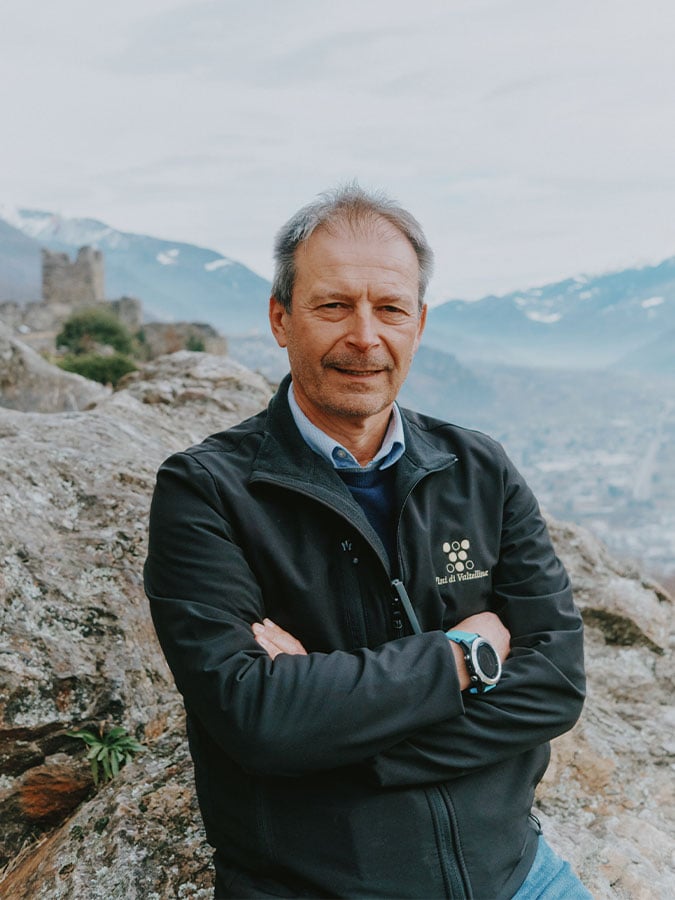

Drocco brings nearly three decades of experience with nebbiolo to Nino Negri, having worked in Barolo as a winemaker at Prunotto and Fontanafredda. After such a long career in the Langhe, what drew him to Valtellina was, partly, curiosity, an urge to understand how nebbiolo responds under such different conditions. In contrast to Barolo’s heavier clay soils, Valtellina’s soils are about 80 percent sand, varied in depth, studded with stones. “The stones give our wines sapidity and texture, and they retain heat from the sun to warm the vines at night. Because there is no clay, we have 30 to 35 percent less tannin than Barolo.
”The climate was also a draw for Drocco. “Maybe it’s not a good thing to say, but climate change has probably helped us,” he admits. In the past, Valtellina growers struggled to ripen their grapes, but now they can reach 13.5 percent alcohol naturally. Barolo growers had historically faced a similar challenge, but in recent years the Langhe has become so warm and dry that alcohol levels regularly rise to 14.5 or 15 percent. “I had the possibility to try lots of Barolo from the sixties and seventies that were naturally 12.5 percent alcohol; 13.5 percent was a good degree in that time,” Drocco recalls. “It could be difficult to manage the elegance in Barolo in the future. Here I am able to make wine that is similar to Barolo from the sixties and seventies.” Since his arrival in 2018, Drocco has moved Nino Negri’s production away from barrique aging in favor of large casks, and initiated a single-vineyard project with three wines (Valgella Vigna Fracia, Inferno Vigna Ca’Guicciardi and Grumello Sassorosso) to highlight terroir influences within the subzones.
Drocco also serves as president of the Valtellina consorzio, and he is acutely aware of the many challenges the region still faces. Valtellina currently has about 2,000 acres of actively managed vineyards, but at its peak, in the mid-19th century, the vineyard area was six times as large, with many more than the 900 small growers that remain today. Switzerland had been Valtellina’s primary market for centuries, but a tax change in the 1980s brought that trade to an abrupt halt, causing grape prices to plummet and growers to abandon vineyards in droves. “Our first target is not to lose any more growers,” says Drocco. “They have to make enough money to live well, or they will do something else.” The big problem is that number everyone quotes: 600-plus labor hours per acre. Grape prices may have rebounded since the 1980s, but not enough to overcome Valtellina’s astronomical labor costs.
Drocco ticks off a few ways that technology might help. Some producers, including Nino Negri, have begun transitioning vineyards from vertical rows to horizontal ones in the a giropoggio style, which allows compact tractors to be used—but this is possible only on some of the less-steep slopes. “We are also working with the Fojannini Foundation to experiment with drones,” Drocco says. This seems out of step in such a traditional region, but Drocco makes a good case. Spraying copper to prevent mildew after a rainfall is one of the biggest challenges in Valtellina. If you don’t spray everything within 24 hours, it’s too late, and you will lose some of the crop. But since all the spraying has to be done manually, it is impossible for many producers to reach all of their vines in time, so some of them resort to using stronger chemicals to guard against peronospora and other mildew diseases. According to Drocco, the new drones are very precise and able to cover lots of ground quickly, which would allow producers to work more organically with copper rather than the harsher chemicals. He admits it would take time to overcome opposition among some growers who distrust the technology; and for now, the drones are strictly experimental, since the EU currently prohibits their use for agriculture. Drocco and the consorzio will have to fight a two-front battle in the coming years, convincing growers to accept drones flying over their vineyards while lobbying for changes in the EU regulations.
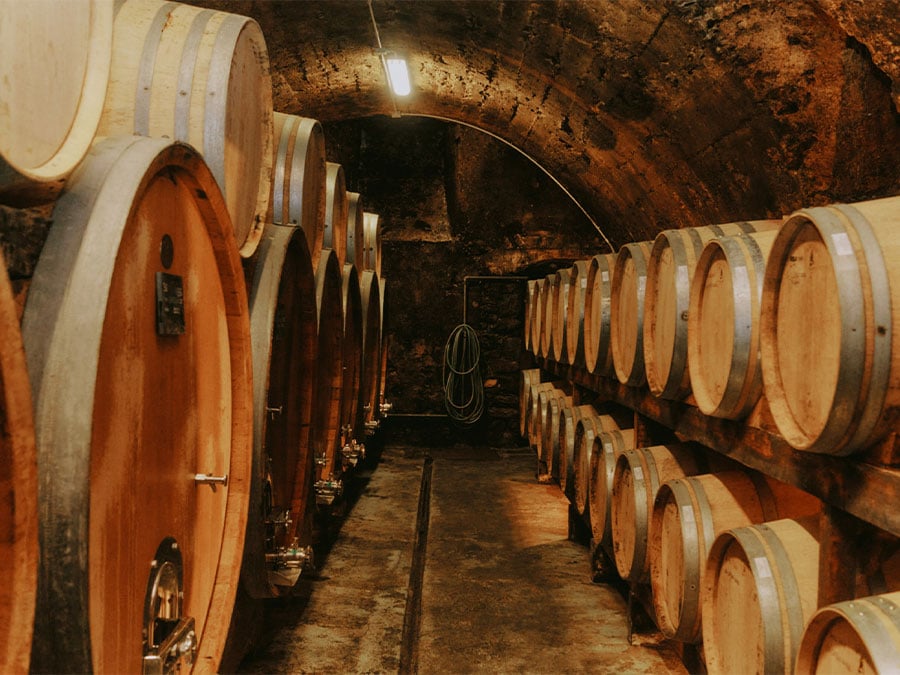

Around the time of the Swiss market collapse, Arturo Pelizzatti Perego was staging a comeback. In 1973, his father had sold the family’s wine business and brand name, Arturo Pelizzatti, to Winefood, a Swiss-American company that had already bought the Nino Negri winery. Most of the family’s 120 vineyard acres were leased out for ten years. After trying his hand at other types of work, Arturo decided he wanted to reclaim his family’s heritage. He regained control of 15 vineyard acres in 1983 and produced his first wines from the 1984 harvest, bottling them under the name Azienda Agricola Arturo Pelizzatti Perego. When the owners of the Arturo Pelizzatti brand threatened to sue him over use of this name, he rebranded his winery using an acronym of his name, and Ar.Pe.Pe. was born.
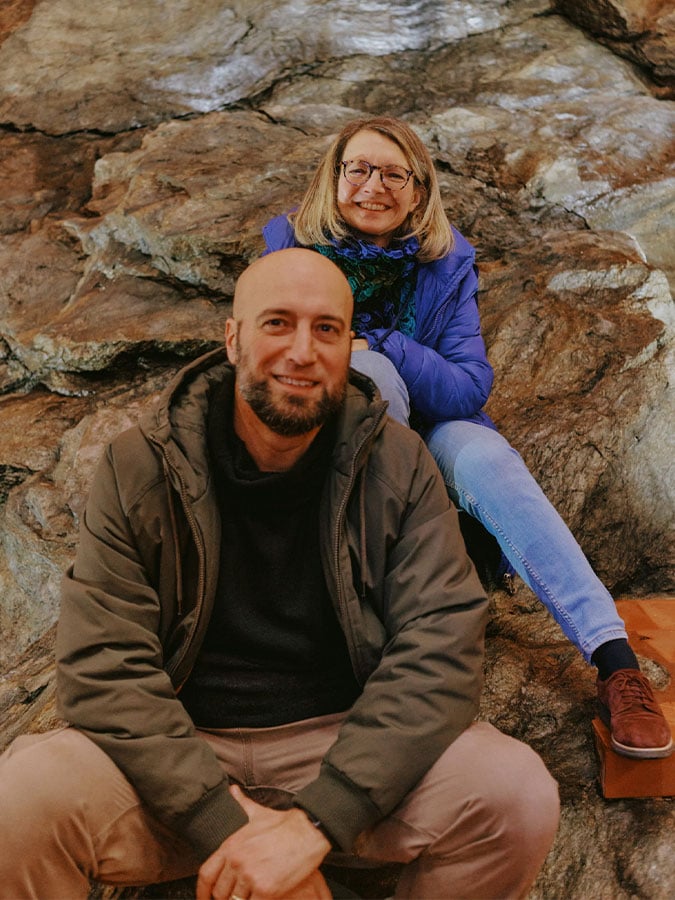

Arturo’s influence on Valtellina’s wine culture and image cannot be overstated. In the early 1980s, the valley was focused on bulk-wine production for the Swiss market. Arturo believed it was possible to produce high-quality wines in Valtellina, and set out to prove it. He revived his vineyards and focused on long macerations and patient aging in large cement tanks and oak casks. Danilo Drocco calls him “one of the drivers of the renaissance” in Valtellina. Marco Ferrari, who worked at Ar.Pe.Pe. during his first two years in the valley, says: “Arturo chose to give dignity to this terroir. You do this when you recognize the heritage, the history, the social moment. He was one of the first to focus on quality wines, and then other people started to follow him.”
A few years before Arturo died in 2004, his daughter, Isabella Pelizzatti Perego, began working at Ar.Pe.Pe. She runs the winery today along with her brothers Emanuele (production) and Guido (social media communications). They produce 110,000 bottles a year from 37 vineyard acres scattered across Sassella, Grumello and Inferno, vinifying the wines at Buon Consigliore, the refurbished family cellar built into the bedrock beneath Grumello’s terraced slope. They continue to follow Arturo’s traditional methods even as they selectively apply new technology to improve their wines: geothermal energy now maintains constant temperatures in the cellar, and they have implemented a system that keeps wine in all of the tanks and casks covered with nitrogen, preventing oxidation and allowing them to use less sulfur.
Still, Ar.Pe.Pe.’s reputation and image remains staunchly traditional. During my visit, Isabella hosted a dinner and tasting at the Camana Veglia restaurant in Livigno, a ski village about two hours north of Sondrio that will host the snowboarding competitions for the 2026 Milano Cortina Winter Olympic Games. She poured Ar.Pe.Pe.’s 2016 Grumello Buon Consiglio Riserva and 2016 Sassella Rocce Rosse Riserva alongside two wines from her family’s original winery: Arturo Pelizzatti 1964 Grumello and 1964 Sassella Riserva, wines that have rested in Camana Veglia’s hotel cellar for more than 50 years. Both had aged beautifully, particularly the ’64 Sassella Riserva, which was positively singing. During the dinner, Isabella mentioned that someone had recently asked her the size of Ar.Pe.Pe.’s tractor team. “Zero,” she scoffed, noting that all of Ar.Pe.Pe.’s vineyards are a rettochino and dismissing tractor use as impossible. I mentioned my conversation with Drocco about the drone experiments, expecting her to be equally dismissive, but instead her eyes lit up. “That is my dream,” she said. “Our biggest opportunity for mechanization is with drones. Treatments are the most challenging work, and if we could do them with less cost and more efficiency, you would use less water. It is better for the plants and for the environment. This is the real new frontier, and if it is successful, it will completely change the opportunity in Valtellina.”
Beyond drones, I ask Isabella, what else would help move Valtellina forward? “Danilo [Drocco] has been bringing a new perspective,” she says. “He could have done a lot of other things, but he chose Valtellina for the special challenge. He believes in the potential for nebbiolo from the Alps.” She views newer producers like Marco Ferrari and Dirupi as positive forces for change. “I look to the younger people to help make a new Valtellina and get rid of the old way of thinking.” She also sees room for another visionary like her father. “My hope is that someone like Roberto Conterno would buy a property in Valtellina. We need a strong person like that to help move the region forward, someone with a clear mission, who has a name for quality and an understanding of the valley. George Clooney could also be helpful. He has a place near Lake Como, and I know he has been enjoying Valtellina wines. Maybe he could put in a word.”
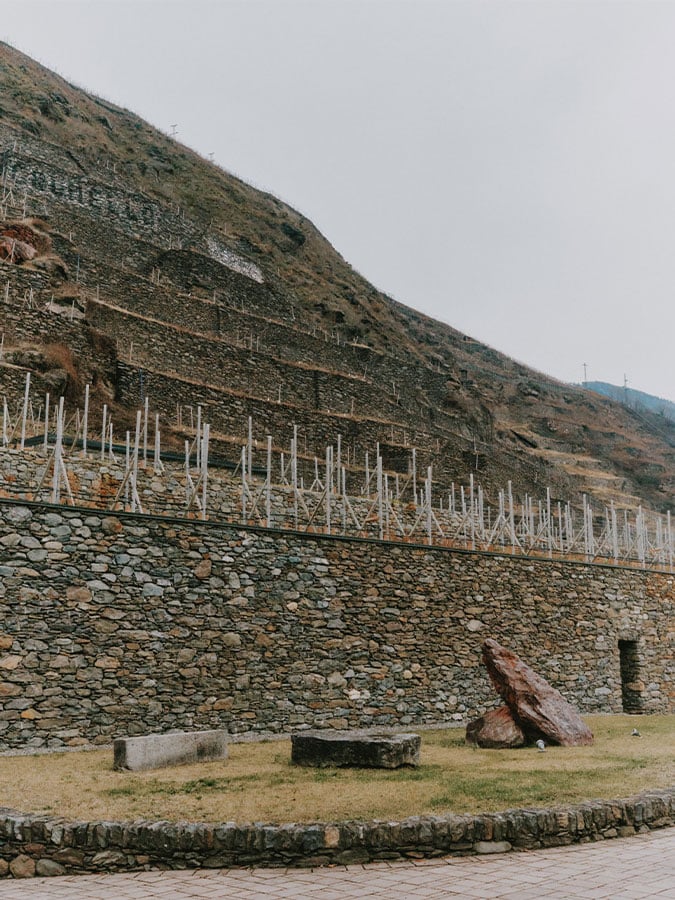

Driving eastward from Sondrio along the Adda River, I reach the tiny hamlet of San Giacomo in the Valgella subzone, where I meet Elena Fay. She works with her brother Marco at SandroFay, the winery started by their father in 1971. (They were forced to combine his first and last name into one word when California’s Stag’s Leap Wine Cellars informed them that they own the rights to the Fay brand name.)
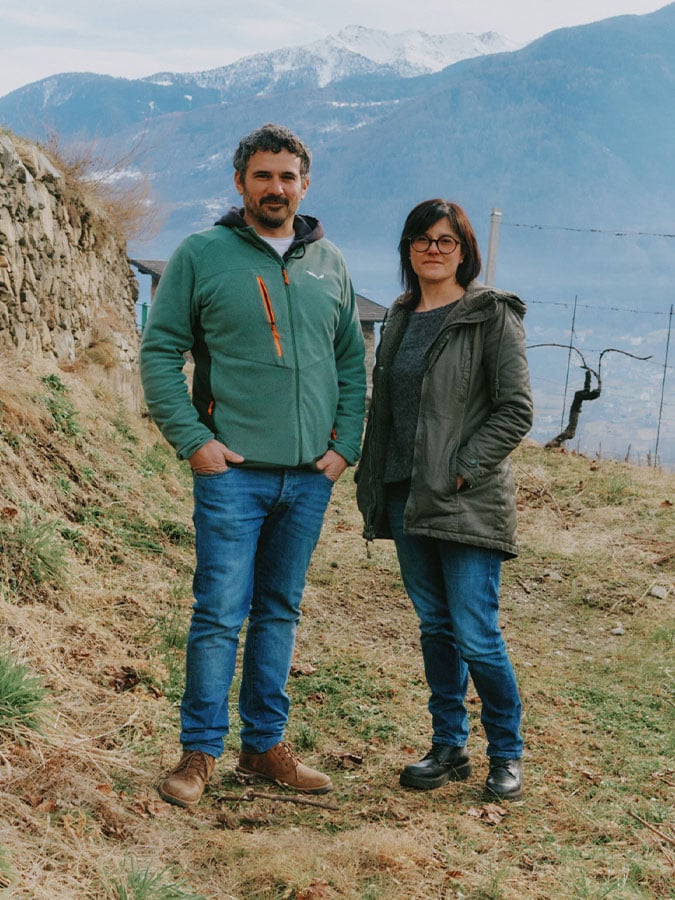

The Fay (rhymes with high) family produces an average of 70,000 bottles a year from 37 acres of vines. Almost all of those vines are in Valgella, Valtellina’s largest subzone with terraced slopes that extend nearly four miles from west to east. In the past, Elena explains, concentrating your vines in one area could be a problem; larger companies would spread their risk by buying grapes or farming vines from multiple subzones, and it was traditional to offer a wine from each subzone. That’s difficult for smaller wineries though, and her family has focused, instead, on single-vineyard wines within the Valgella subzone. They began using the name of their Cà Moréi vineyard on one of their labels in 1983, well before such geographical units were officially recognized. In addition to the silky Cà Moréi from an eastern plot in Valgella, they make the bright and spicy Carterìa Riserva from a parcel on Valgella’s western side.
As we wind our way up the switchback road toward Cà Moréi, which sits in that goldilocks zone of around 1,800 feet a.s.l., the discussion turns to the steep vineyards and the challenges of working in Valtellina. Elena expresses reservations about drones, questioning whether they can ever be precise enough to spray only on the bunches where the treatments are most needed. In any case, SandroFay has less need for drones; around 60 percent of their vineyards are now planted a giropoggio, allowing use of a small tractor that speeds up treatments.
Above us, the forest rises all the way to the top of the hill until it reaches the medieval tower of Teglio Castle. Just below the tree line lies a new vineyard, which the family bought in 2014. Elena tells me that there are old terraces and abandoned vineyards all over these high forests, vestiges of a more prosperous and productive Valtellina. At nearly 2,800 feet a.s.l., the Fays’ new vineyard is beyond the current upper limit for Valtellina Superiore DOCG wines, so they have planted white grapes—for now. They view it as an investment for the future, a hedge against a time when Valtellina’s slopes could become too warm for the kind of elegant nebbiolo wines they want to produce. “We are lucky, because in the Langhe they can’t decide to plant higher; they are at the limit. In Valtellina, we can go up. Maybe this vineyard is not yet ready for nebbiolo, but we will preserve viticulture there. In 20 years, my son might need to put nebbiolo there, and I can give him the vineyard to do it.
is the Italian wine editor at Wine & Spirits magazine.
This story appears in the print issue of Spring 2024.
Like what you read? Subscribe today.


